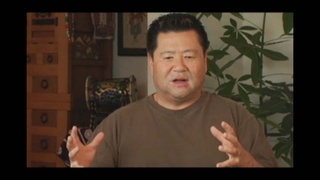Interviews
Changing the taiko rhythm from Japanese to Afro-Cuban
The fact that George was in the group really was important because his father was a biwa teacher and so George grew up with Japanese music. So his sense of rhythm also is Japanese. It was very Japanese-y at first. Most taiko groups now – it’s Afro-Cuban because that’s our upbringing. They’re not exposed to Japanese music at all. So that if you listen to American taiko, the one thing that overwhelmingly distinguishes it is every space is filled and it’s real fast and it’s real loud, and there’s no…
Whereas Japanese rhythm is limited but it’s spacey. It’s based on a melody and George is from that tradition and I’m chanting. So when we got together, one of our early pieces was we beat out the Amida-kyo – the Amida Sutra. Every beat. From that comes a natural syncopation [chants]. And we took sections of that and put them together as pieces.
In the beginning it was very Japanese. Now it’s Sansei-Yonsei. It’s more Afro-Cuban because that’s the American influence. So it’s less Japanese as we go on, I would think. So here we’ve been trying to expose our kids to more Japanese music or Asian music because there is that difference.
Date: December 3, 2004
Location: California, US
Interviewer: Art Hansen, Sojin Kim
Contributed by: Watase Media Arts Center, Japanese American National Museum




